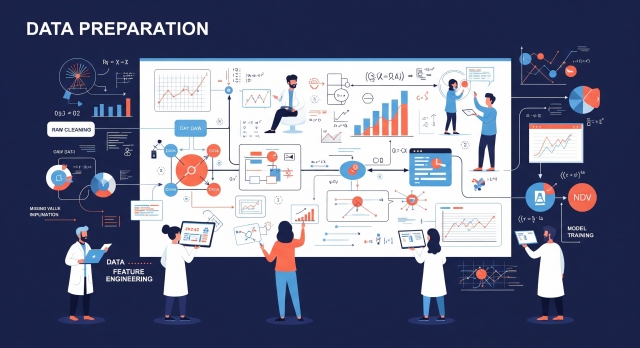Machine learning thrives on good data. Without proper preparation, even the smartest algorithms fail. This guide breaks down 11 essential best practices for preparing data covering cleansing, transformation, annotation, and automation so your AI models deliver reliable, scalable, and business-ready insights. Think of it as your blueprint for AI success.
Machine learning is transforming industries with automation, smarter decisions, and personalized experiences. But here’s the thing: the best models don’t fail because of bad algorithms; they fail because of bad data. “Garbage in, garbage out” still holds true. Poor preparation creates unreliable results, while clean, structured, and annotated data unlocks trustworthy AI performance.
Global businesses lose billions every year due to data quality issues. That’s why structured preparation and professional data annotation services aren’t optional, they’re critical. Let’s walk through 11 proven best practices that make your machine learning projects faster, more accurate, and far more valuable.
What is Data Preparation and Why It Matters
Data preparation (or preprocessing) is the process of turning raw data into something your algorithms can use. It involves cleaning, transforming, and structuring data so models can learn effectively.
High-quality data should meet these benchmarks:
- Completeness: Minimal missing values
- Uniqueness: No duplicate records skewing results
- Accuracy: Aligned with source-of-truth standards
- Timeliness: Always current and relevant
- Consistency: Logically aligned across datasets
- Fitness for Purpose: Directly tied to the business problem
Skip these, and you risk higher costs, slower insights, and model failures. This is why many companies outsource data annotation and labeling services to accelerate preparation while maintaining quality.
The 11 Best Practices for Data Preparation in Machine Learning
1. Start with the Business Problem
Every project begins with clarity. Define what you’re solving customer churn, fraud detection, predictive maintenance. When you know the goal, you collect only the most relevant data, avoiding noise that weakens your model.
2. Collect & Integrate Data from Multiple Sources
ML rarely runs on one clean database. You’ll need to merge structured data (like CRM systems) with unstructured sources (images, text, IoT devices). Integration gives you a complete view but also introduces inconsistencies, so plan preprocessing carefully.
3. Clean the Data Thoroughly
This is where most of the time goes up to 80% of a data scientist’s effort. Key steps include:
- Filling or removing missing values
- Identifying and deleting duplicates (which can inflate accuracy by 10%)
- Fixing structural errors like inconsistent formats
- Handling outliers with techniques like log scaling or IQR checks
4. Transform Data for Algorithm Needs
Different algorithms need data in different formats. That means:
- Normalizing and scaling features
- Encoding categorical variables into numbers
- Correcting skewed distributions
- Tokenizing and vectorizing text for NLP
5. Engineer Features for Better Predictions
Raw data doesn’t always tell the full story. Create new features that add predictive value, like customer lifetime value (CLV) or engagement ratios. Feature engineering is often the difference between an average and an exceptional model.
6. Use Feature Selection & Dimensionality Reduction
Too many features slow models and add noise. Apply methods like PCA or recursive feature elimination to strip away the unnecessary and keep only the most impactful variables.
7. Fix Data Imbalance
In fraud detection or rare disease datasets, minority classes are underrepresented. Balance them by oversampling, under sampling, or using synthetic data (SMOTE). You can also adjust algorithms with weight loss functions.
8. Split Data for Training, Validation, and Testing
Always divide your dataset:
- 70% for training
- 15% for validation
- 15% for testing
This ensures your model generalizes well and avoids overfitting.
9. Continuously Validate Data
Data isn’t static. What’s valid today might be outdated tomorrow. Regular validation detects shifts (concept drift) and keeps models trustworthy over time.
10. Document & Version Control Everything
Preparation involves dozens of steps. Document transformations, aggregation methods, and assumptions so others can reproduce results. Tools like Data Version Control (DVC) make tracking changes seamless.
11. Automate with Tools & Services
Manual prep is slow. Automate repetitive tasks with tools like TensorFlow Data Validation and rely on expert annotation services to scale faster. This frees your data team to focus on building and improving models.
From Data Preparation to AI Success
Preparation isn’t just about technical hygiene it’s a business growth strategy. Clean, annotated, and well-structured datasets power reliable AI systems that reduce costs, speed up decisions, and increase trust.
- In healthcare, clean data improves diagnostic accuracy.
- In finance, structured preparation cuts false fraud alerts.
- In retail, annotated datasets enable accurate recommendation engines.
When ignored, poor data preparation leads to costly failures. Done right, it becomes the backbone of AI success.
Conclusion
The future of AI won’t be decided by algorithms alone. It will be decided by data quality. By following these 11 best practices, from cleaning and transformation to validation and automation you can make your machine learning models smarter, faster, and more reliable.
Companies that prioritize data preparation today will lead tomorrow. Those that don’t will keep paying the price of poor decisions powered by poor data.






